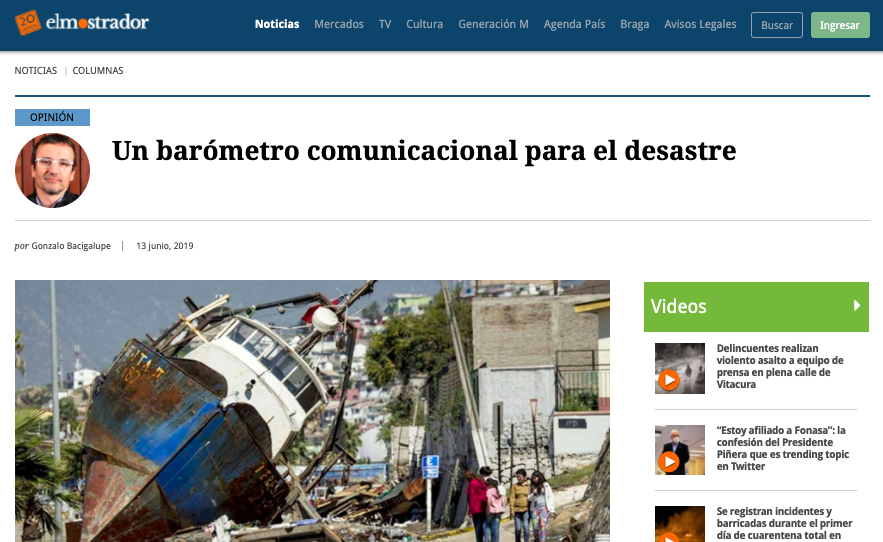By Gonzalo Bacigalupe.
The number of people getting information every day through print media has significantly dropped compared to digital press and media used by connected people in their day to day. The need to be informed in order to reduce uncertainty in the event of disasters can increase the amount of false information. It flows faster through private means of communication such as WhatsApp. But connected people do not necessarily accept fake news, there is a growing knowledge that prevents the latter from being accepted point blank. Connected people can be the most under-used resource and, at the same time, the most powerful one.
As we already mentioned, the country faced an emergency resulting from the behavior of nature. Rain and wind gust warnings, followed by several “occasional but real” tornadoes took over the media and family or work discussions. Our history is filled with these events, they are part of our identity. At CIGIDEN, we are currently analyzing data from a national survey to connected citizens, who answered several questions about their communication habits, risk perception, confidence in authorities and fake news flooding social media during disasters and emergencies. According to our respondents, traditional media cover relevant events, but most of them do not trust the information provided therein.
A greater number of people mistrust the information provided by newspapers, television and radio stations, compared to those that do trust this type of information. Nonetheless, they believe that information provided by media such as Facebook or Twitter is even more unprecise than that provided by more traditional media.
The number of people getting daily information through written media has significantly dropped compared to digital press and media used every day. Connected people are mostly concerned about environmental, scientific and technological issues, whereas crime, sports and gossip are at the bottom of the list.
That said, the fact that more people are getting information through social media makes access to fake news easy. Fake news could have a particularly negative impact upon an emergency or disaster.
Fake news seem to gain relevance when it comes to issues concerning disasters, the environment and health. Something similar happens when it comes to credibility. The most credible news are those related to health and environmental issues, and people tend to share them too.
According to our survey, social media have not replaced traditional media, but they have paired with them. Upon natural disasters such as those that took place last week, when several tornadoes reminded us that nature does not conform to our housing decisions, terrorized citizens were both gathering and creating information through pictures and videos taken with their mobile phones and immediately shared with other people. Additionally, this pairing up is from citizens to media, especially during the emergency.
The terrorizing vision of a couple from an apartment in one of the cities struck by the tornado became part of the news of a television station. Connected citizens built the experience of the emergency along with the journalist interviewing people who lost their homes. At least for a few hours, both the emergency and reality itself were jointly built by those having access to social networks. Later, the media generated the official speech around them.
When faced with the hypothetical scenario of a disaster taking place in their living area, and, despite being safe, still not being aware of the magnitude of the damages or if relatives were affected, the respondents said their first choice for information about the situation would be turning on the radio, television or making a phone.
However, private social media also become the first choice. WhatsApp is as relevant as radio broadcasts or a phone call. Although our respondents have certain preferences, we must assume that they all belong to the same person. We listen to the radio, watch television, text our cousins and friends and try to call our grandmother.
Notwithstanding this, the need for information to reduce uncertainty might increase the amount of fake news. It even flows faster through private communication means such as WhatsApp. Public social media like Facebook and Twitter are part of this flow, but they also have the ability to easily disprove them. Connected people do not necessarily accept fake news, there is a growing knowledge that prevents the latter from being accepted point blank. Learning from and recognizing people’s communication wisdom is key.
Further research allowing us to understand the use of private communication means and the use by emergency managers of the same media to inform and get information, is of much relevance. In fact, a previous study on the use of social networks found that there are online volunteer networks who are very active on sharing information useful to their peers. Connected people can be the most under-used resource and, at the same time, the most powerful one.
In short, uncertainty regarding nature’s behavior is always present and frequent in our country. We are not safe when unable to predict the future, we cannot decide what to do, there is much ambiguity and there is a general feeling of doubt and concern. Under these circumstances, traditional communication means play a central role. People turn on the radio and the television.
During the last decade, however, social media have quickly paired up with those tools we usually use to reduce uncertainty. In recent years, the massive penetration of WhatsApp, a private communication means of which us researchers know little about, since only the private networks we are part of have access to the information that flows through it.
Click here to read the piece published in El Mostrador
